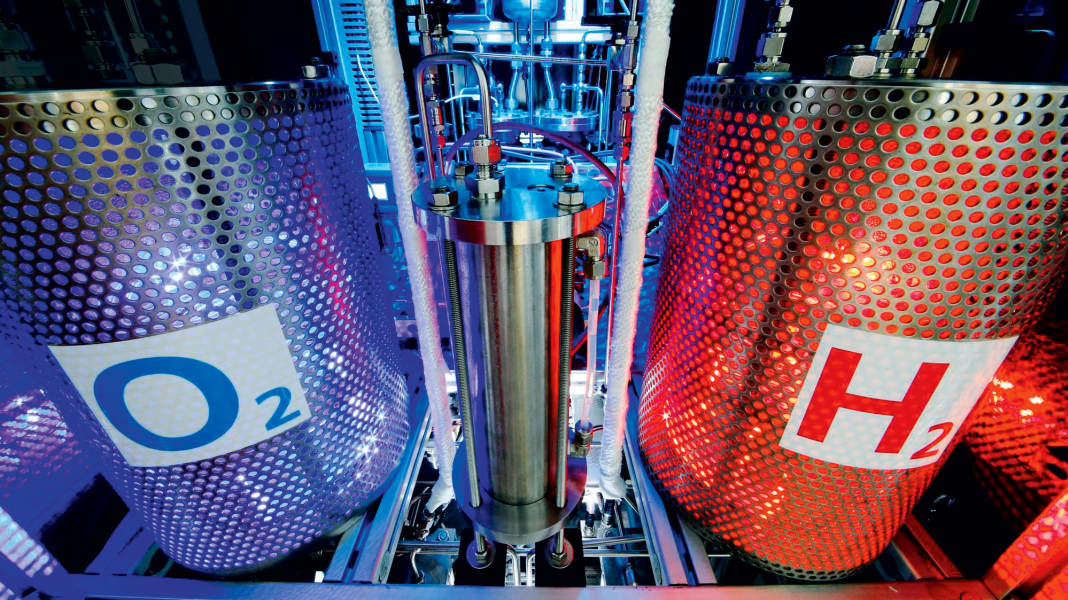
It was high time that decarbonisation also continued in yachting. However, it was not foreseeable that the Libyan dictator Muammar al-Gaddafi would be associated with the terms hydrogen, fuel cell and yacht. His Sunseeker 95 Predator ran aground in a Maltese shipyard after coming into contact with a reef in 2008 and was sold to Green Yacht by his heirs. The Norwegian company found what it was looking for in the hull: high speed potential, a large engine compartment - and was naturally happy to accept the media response that the colourful "revolutionary leader" triggered even after his death.
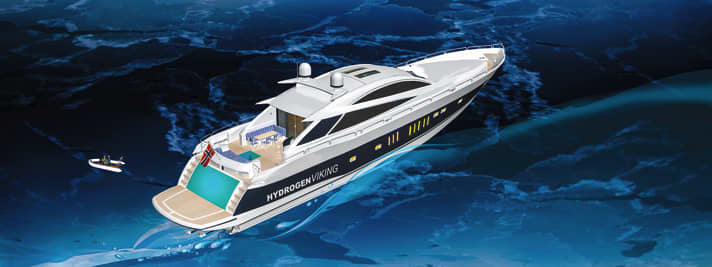
The 28.75 metre long GRP construction, which was launched in 2005, reached Bergen a year ago. Che Guevara" is currently being converted into "Hydrogen Viking" and will now be fitted with electric motors, a battery bank and "several megawatts" of fuel cells from Toyota instead of the two MTU sixteen-cylinder engines and the two generators. The hydrogen required will be stored aft in pressurised tanks and staged via a glass lazarette. Bergen-based designer Rory Coase is overseeing the conversion project, which will see the saloon transformed into a conference room for up to 30 people. From the summer, "Hydrogen Viking" will serve as a floating showroom to attract refit customers to Green Yacht in Norway.
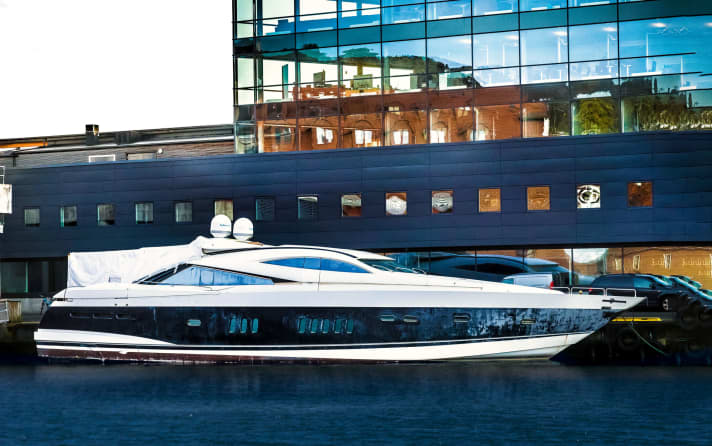

The French start-up Hynova, which is marketing its 40-foot model as the world's first mass-produced hydrogen-powered sports boat, is already writing orders. The founder is Chloé Zaied from Marseille, whose work as a captain for excursions in the Calanques National Park made her realise the need for emission-free propulsion. Under the aft sunbathing area of the Hynova 40 are 22.5 kilograms of hydrogen in three cylindrical containers. The Hynova 42 offers a slimmer solution, with its drive train discreetly concealed in the bulbous hull. The design by Chloé Zaied has the tender and chase boat market in mind, is built in La Ciotat and aims to impress with a maximum range of 150 nautical miles and a top speed of 30 knots.
Series-produced sports boats already refuel with hydrogen
Hynova uses marinised fuel cells with 80 kilowatts of power from EODev, which are combined with batteries to increase efficiency. The commercial offshoot of the "Energy Observer" catamaran is developing its power sources together with Toyota, the Japanese hydrogen leader on the road and shareholder of EODev. Lower-power fuel cells, such as those from Efoy, have been on the market for over ten years and provide additional power on numerous sailing boats. As soon as external hydrogen tanks are used on large engine formats, volume limits are quickly reached.
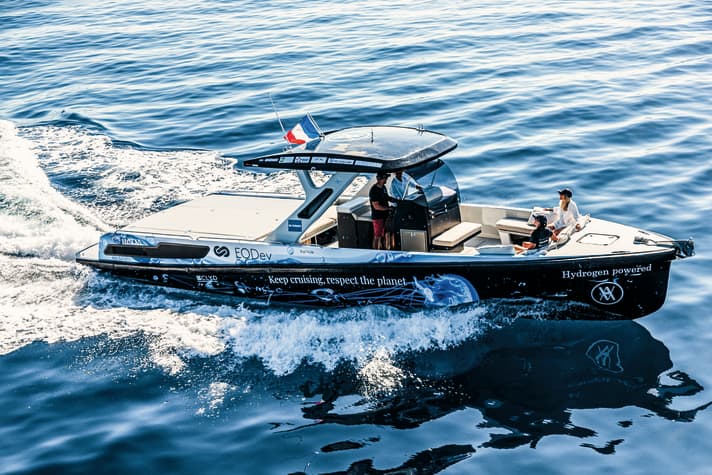
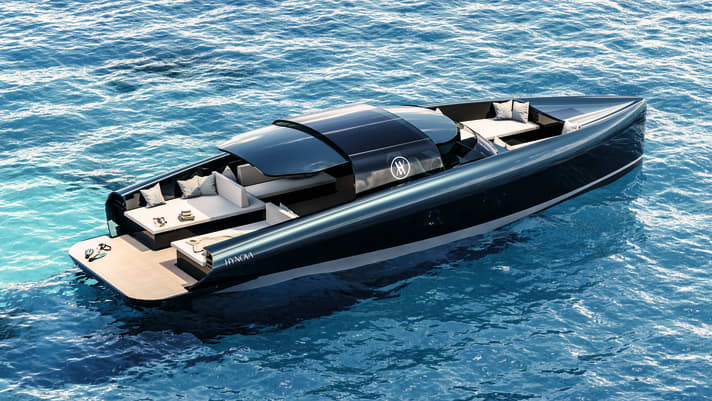
This is made particularly clear by the few pure hydrogen concepts, such as the 65-metre "Waterecho" project presented by Espen Øino and Viareggio Superyachts in 2018 or Sinot's futuristic 112-metre "Aqua". For good reasons, they were only available in virtual form. Although the H2 cylinders are lighter than diesel bunkers and could be flexibly arranged alongside the ship, they would extend over two decks and mean a serious loss of interior space - even if hydrogen is compressed as usual using high pressure. At sea, this would be possible at 350 bar; the automotive industry is allowed to operate tanks at 700 bar for a 25 per cent increase in capacity. The energy required for compression should not be neglected. Liquid hydrogen storage at minus 253 degrees Celsius is also out of the question, as the energy density is still seven times lower than that of diesel.
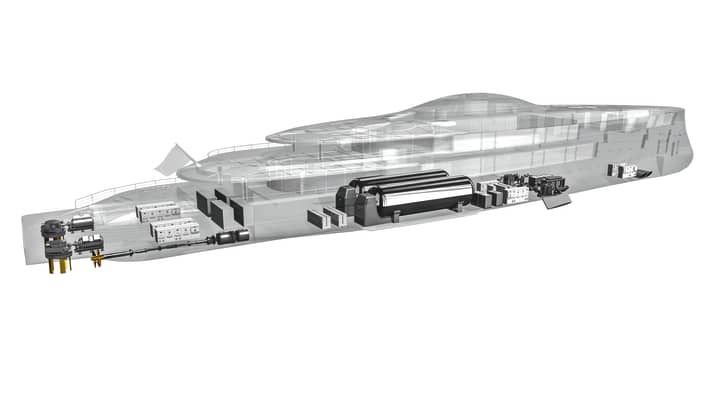
As direct-hydrogen systems for energy-hungry superyachts with a focus on living space are out of the question, the focus remains on the basic component, the fuel cell (box). Large yacht builders such as Lürssen have discovered methanol as a bunker fuel. The simple alcohol is liquid under normal conditions - and therefore comparable to diesel in terms of storage. The flash point is similar to that of petrol. On board, methanol passes through a reformer where it is heated and broken down into its components. One of these is hydrogen, which goes to the fuel cell. The other by-products from the methanol vapour reforming process - which uses the waste heat from the fuel cell - are oxygen and carbon dioxide, both of which escape into the air. No greenhouse gases are emitted when using green, climate-neutral methanol.
Lürssen is not going down the "methanol fuel cell" route alone. Contrary to the otherwise discreet communication policy regarding ongoing projects, Peter Lürssen announced at the beginning of 2021 that an owner wanted this technology in a new build. A shore-based test rig is about to be commissioned, and Lürssen has its sights firmly set on the delivery of the "hydrogen yacht". In Freudenberg Sealing Technologies, the Bremen-based company has chosen a partner who, like the shipyard, is part of the Pa-X-ell 2 research network and has over 30 years of experience. Prefabricated system units consisting of fuel cell stacks with a megawatt output, reformer and control electronics as well as all cables are supplied from Weinheim am Rhein. The electrical energy feeds the e-drive and the on-board network - emission-neutral and low in noise and vibration. For reasons of range guarantee and route flexibility, however, the fuel cells still act as a complement to diesel generators.
Fuel cells find their way onto large yachts
A similar hybrid system consisting of liquefied natural gas (LNG) as the primary energy source and fuel cells from Freudenberg will soon be travelling on the "Aida Nova". The Meyer shipyard retrofitted the 337-metre-long cruise ship with a heavy-duty application at the end of 2020, which is expected to run for more than 35,000 operating hours. Sanlorenzo plans to deliver an application example for a 50-metre yacht in 2024. For the hydrogen yacht commissioned by CEO Massimo Perotti, the Italians are cooperating with Siemens Energy and are pursuing a similar approach to Lürssen: they are relying on methanol, from which an upstream reformer converts the temporarily stored energy back into hydrogen and transfers it to a fuel cell.
Paolo Bertetti, Vice President of Sanlorenzo's development department, gives an idea of the scale and calculates: "A 50 metre long yacht would have to carry 5000 to 6000 litres of methanol to cover the hotel load for a week." Yachts of this length currently bunker around ten times the amount of diesel for propulsion and on-board power. The idea is to replace the diesel-electric system during idle times, for example when at anchor, and not to support it for propulsion purposes. Bertetti concludes: "There won't be a fuel cell main propulsion system before 2030."
Demand for green methanol on the rise
Methanol is therefore a hydrogen carrier which, thanks to its uncomplicated storage, also makes the use of fuel cells interesting for large yachts. The power generators in cabinet format are scalable and have therefore become so powerful that they could cover the propulsion and on-board power supply. What is lacking is experience - and methanol, which is green. However, demand is increasing and is also coming from a sector that is one of the world's biggest CO2 emitters: container shipping, which aims to be climate-neutral by 2050. From 2024, the Danish Maersk shipping company expects twelve freighters whose MAN gensets will run on both diesel and methanol directly.
Operation with grey methanol would result in CO2 emissions, but less particulate matter and air pollutants. A consortium therefore wants to produce green methanol, of which 450000 tonnes are required annually. For comparison: Europe's largest methanol producer, the Total refinery in Leuna, produces 700,000 tonnes of grey methanol per year, i.e. based on fossil raw materials. The French company recently inaugurated a one-megawatt electrolyser in Saxony-Anhalt, and the gas group Linde wants to produce 3200 tonnes of green methanol per year in Leuna with the world's largest PEM hydrogen electrolyser with 24 megawatts of power.
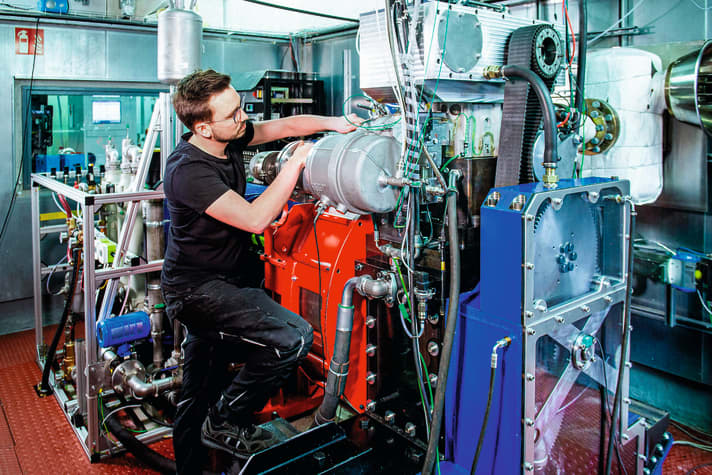
Rolls-Royce Power Systems is also involved in methanol production using renewable energy sources as part of the MethQuest project. The aim is to increase availability, especially in harbours, and promote the spread of MTU's new methanol engines. Rescue may be coming from above. The German Aerospace Centre (DLR) in Jülich is working on using the world's largest artificial sun to produce hydrogen at low cost. This could be used to produce green methanol or synthetic, CO2-neutral diesel. It would then require solar thermal plants in sunny countries that run without electricity and solely on light.
Interview: "Pure fuel cell yacht in ten years"
Dr Justus Reinke has been one of four managing directors of the Lürssen yacht division for four years. As the person responsible for technology and innovation, the 40-year-old industrial engineer is the first point of contact for the anticipated "hydrogen new build".
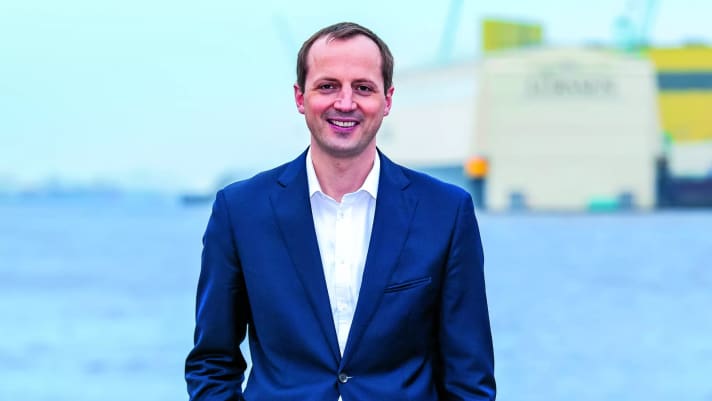
Successful implementation of new technologies requires strong partners. How did Lürssen and the fuel cell supplier Freudenberg come together?
In 2018, we were looking for a competent fuel cell partner for our Pa-X-ell fuel cell project. We chose Freudenberg because of their many years of experience with fuel cells and their components. Their focus is on heavy-duty applications, i.e. systems with increased lifetime and efficiency requirements. At the same time, Freudenberg benefits from the innovative expertise of the Lürssen Group. We receive a complete system that also contains the reformer that extracts hydrogen from methanol on board - a technically very complex interface. Freudenberg can also supply batteries if required and thus takes responsibility for the entire system. This collaboration now goes beyond Pa-X-ell and involves specific orders.
The engine compartment becomes a reaction chamber.
In future, there will be significantly fewer mechanically stressed parts. This will also have a positive impact on life cycle costs and the degree of freedom in the design. This also applies to the decentralised placement of individual components. The 'engine compartments' of yachts powered exclusively by fuel cells will be smaller than those of diesel units. Systems such as silencers and exhaust gas aftertreatment will no longer be required. In addition, today we have to deal with very large shafts to move air and exhaust gas. These could be smaller in the future.
Lürssen presented plans for a test centre almost a year ago. When will it go online?
The latest generation of Freudenberg's fuel cells is currently in the prototype/pre-series phase. The aim is to increase energy density. Participants in the Pa-X-ell project have already carried out trials with pre-series models, and there are systems on land that have already completed very long test periods. The development and construction of the test rig at Lürssen have been completed. As soon as Freudenberg's overall system has been certified and approved, the fuel cell can be integrated into the test rig. Full operational readiness should be achieved by the middle of the year.
How many fuel cells will Lürssen's "hydrogen yacht" have, and what output will they have?
The decisive factor is the amount of power required and therefore the size of the yacht. The use of hydrogen fuel cells with methanol reformation includes a corresponding power grid, known from diesel electrics, and an electric drive component. On the way to a pure fuel cell yacht, we could gradually replace diesel generators with fuel cells that are easily scalable as reliability increases. For our project currently under construction, we are planning two 500-kilowatt fuel cell systems. With one megawatt of power, 1000 nautical miles at low speed or 15 days CO2-neutral at anchor are possible.
On board, hydrogen is produced from methanol. Where and how is the liquid fuel stored?
We can integrate the tanks into the double floor in a similar way to diesel. As methanol is liquid at ambient temperature, the tank can follow the ship's structure and utilise the space optimally. This is a significant advantage over hydrogen, which has to be stored in very cold liquid form or in gaseous form in large pressurised tanks. The space required would not be in proportion to the energy density. Methanol is relatively easy to handle and its flash point is comparable to that of petrol. The potential risk to marine waters is also lower with methanol than with diesel or petrol. When methanol is produced using renewable energy, it results in a CO2-neutral cycle. The CO2 that is bound in this green methanol and is released during hydrogen production was previously removed from the atmosphere.
What is the bunker situation for methanol?
Methanol is available everywhere today and is a precursor or by-product of many industrial processes. Availability is high, although grey, non-CO2-neutral methanol still dominates the market today. However, there is a clear development trend towards green methanol. Various consortia are emerging that are dedicated to the production and availability of methanol in harbours. The Maersk shipping company and the MethQuest project are just two examples.
How big are the methanol reformers?
In principle, they look like control cabinets and are roughly the size of a fuel cell stack. A reformer supplies a 500-kilowatt unit, consisting of five 100-kilowatt stacks, with hydrogen.
How user-friendly and maintenance-intensive is the fuel cell system?
As with diesel-electric yachts, the first engineers will also need to have a high level of electrical engineering expertise and knowledge of methanol as a fuel. Due to the lower mechanical stress, the curves for fuel cells are flatter. When stacks reach the end of their life cycle, they can easily be replaced or extended, as the cabinets are door-mounted. We assume that maintenance costs will be lower over a certain period of time during operation.
During the online event "Lürssen Live!", Peter Lürßen said that he does not see the fossil-free future in lithium-ion batteries. How do you see that?
As pure energy storage devices, batteries are incredibly large and heavy on board. Their energy density exceeds any sensible requirement and they cannot be a pure energy path for yachts. However, some form of energy storage will always be necessary in addition to the fuel cell, as the fuel cell is relatively inert, and batteries are needed for this. However, batteries are currently not suitable as a primary energy source for yachts.
In 1886, Lürssen built the world's first motorboat with an internal combustion engine. When will the first fossil-free powered large yacht be a reality?
First of all, we are focussing on the successful delivery of our first yacht with fuel cell technology. We are already seeing a great deal of interest in the discussions we are having with customers for new build projects. Together with Freudenberg, we have the vision of developing in the direction of a pure fuel cell yacht. Our aim is to be able to realise such projects in ten years at the latest.
The Lürssen test stand
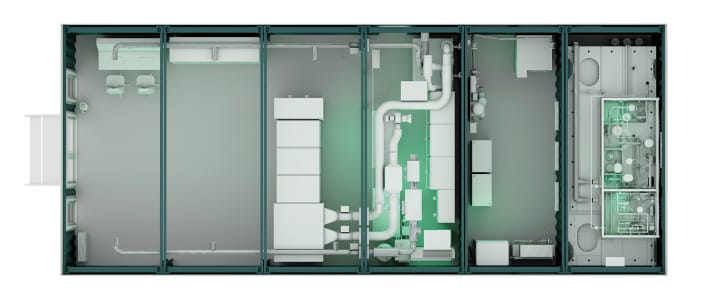
Rooms from left to right:
- Control room
- Sluice
- Fuel cells and reformers
- Technical room
- Ventilation and cooling equipment
- Double-walled methanol tank
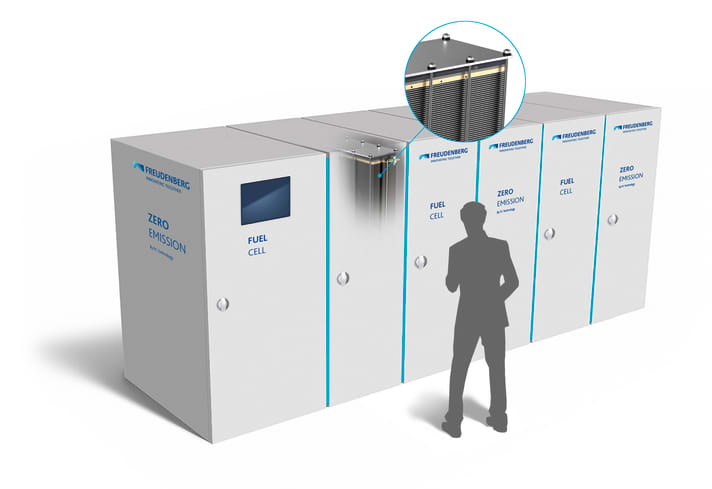
How a fuel cell works
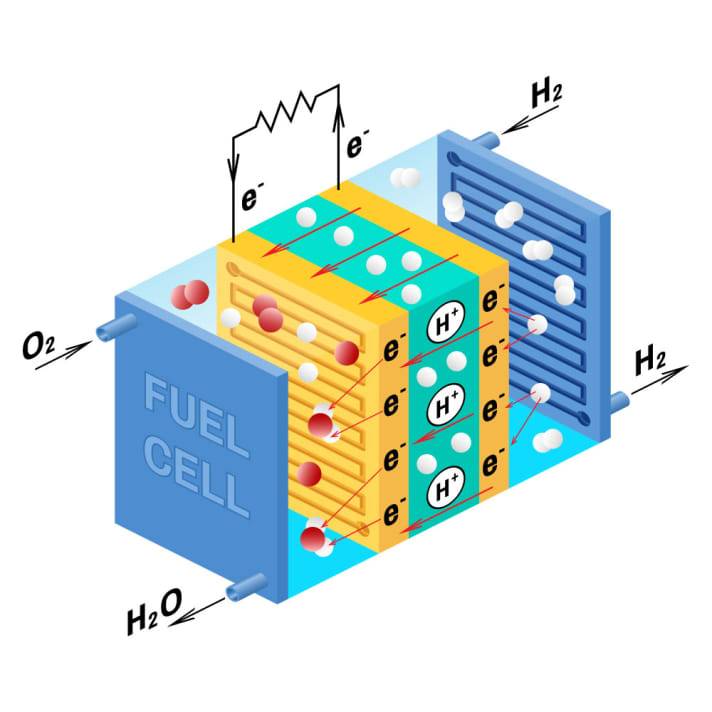
It works in a similar way to a battery. Two electrodes (anode and cathode) are separated into two half-spaces by a membrane. Hydrogen flows into one and oxygen into the other. The hydrogen is broken down into its components: two electrons and two protons. The protons pass through the membrane into the other half-space, into which oxygen flows. In order to reach the oxygen side - where there is a shortage of electrons - the electrons are sent via an external circuit. Direct current flows. However, the voltage per cell is only about one volt. To generate more current, the cells are stacked on top of each other to form a "stack". According to fuel cell manufacturer Freudenberg, around 4000 individual cells are required for an output of 80 kilowatts.

